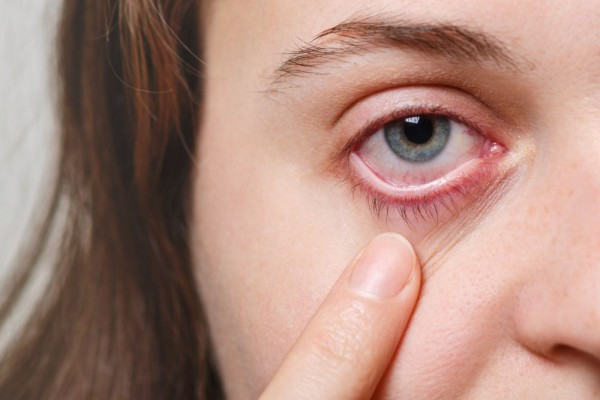Definisi
Astigmatisme atau yang lebih dikenal dengan mata silindris, merupakan ketidaksempurnaan lengkung selaput bening (kornea) atau lensa mata yang menyebabkan penglihatan menjadi kabur atau terdistorsi pada jarak berapapun. Kondisi ini termasuk dalam kelainan refraksi atau pembiasan cahaya pada mata, satu kelompok dengan rabun jauh (miopia) dan rabun dekat (hipermetropia). Pada umumnya, kondisi astigmatisme dapat ditangani.
Di seluruh dunia, prevalensi astigmatisme tertinggi adalah pada orang dewasa di Asia Tenggara. Pada sebuah penelitian, ditemukan bahwa sekitar 14,9% dari seluruh anak dan 40,4% dari seluruh orang dewasa di dunia memiliki astigmatisme. Di Asia Tenggara sendiri, sekitar 9,8% dari seluruh anak dan 44,8% dari seluruh orang dewasa memiliki astigmatisme.
Penyebab
Mata normal memiliki kornea dan lensa yang dapat diibaratkan sebagai bola kaca yang lengkungannya rata, sehingga cahaya dapat dibiaskan dengan baik untuk membentuk satu bayangan yang jelas di retina. Namun, pada kondisi astigmatisme, salah satu di antara kornea atau lensa berbentuk lonjong seperti telur, sehingga ada perbedaan lengkungan. Perbedaan lengkungan ini menyebabkan pembiasan cahaya menjadi tidak sama sehingga terbentuk dua bayangan di retina. Kedua bayangan ini saling bertindihan sehingga menyebabkan penglihatan menjadi kabur. Penglihatan yang kabur ini dapat terjadi pada berbagai arah: horizontal, vertikal, atau pun diagonal.
Faktor Risiko
Astigmatisme dapat terjadi sejak lahir atau berkembang setelah anak-anak atau dewasa. Kondisi ini dapat pula berkembang setelah cedera, penyakit, atau operasi mata. Selain itu, astigmatisme dapat pula diturunkan dari orangtua ke anaknya. Hal ini menunjukkan bahwa setiap orang memiliki bentuk dan kelengkungan kornea dan lensa mata, dan sebagian orang memiliki perbedaan lengkung yang menyebabkan astigmatisme. Namun, mitos bahwa astigmatisme terjadi karena membaca di tempat gelap, membaca atau menonton TV terlalu dekat itu tidak benar.
Gejala
Anak yang mengalami astigmatisme mungkin tidak akan menyadari gejalanya. Oleh karena itu, penting untuk memeriksakan mata anak secara rutin untuk mengecek adanya kelainan refraksi atau tidak. Pemeriksaan ini sebaiknya dimulai sedari dini supaya bisa segera dikoreksi dengan kaca mata.
Sementara itu, anak yang lebih besar atau orang dewasa biasanya mengeluhkan penglihatan yang kabur atau terdistorsi. Distorsi penglihatan dapat terlihat seperti kaca lengkung yang membuat Anda terlihat lebih gemuk atau lebih kurus, terlalu tinggi atau terlalu pendek. Selain itu, keluhan dapat disertai dengan rasa pegal di mata, sakit kepala, kesulitan melihat pada malam hari, serta memicingkan mata untuk memperjelas penglihatan.
Namun, adanya gejala-gejala ini tidak memastikan adanya astigmatisme. Oleh karena itu, jika Anda atau anak Anda mengalami hal ini, segeralah periksakan ke dokter mata.
Diagnosis
Diagnosis astigmatisme dapat dilakukan oleh dokter mata maupun dokter umum. Dokter pertama-tama akan memeriksa ketajaman penglihatan Anda dengan menggunakan Snellen chart, yaitu menunjukkan huruf-huruf dan menginstruksikan Anda untuk membacanya. Pemeriksaan ini akan menentukan ketajaman penglihatan Anda pada jarak tertentu. Setelah itu, dokter akan meminta Anda untuk melihat garis yang tersusun seperti jam dan menentukan pada jam atau derajat berapa penglihatan Anda paling kabur.
Pemeriksaan ini dapat dilakukan dengan menggunakan trial lens untuk menentukan kekuatan lensa kacamata yang Anda perlukan. Selain trial lens, alternatif lainnya yang dapat digunakan oleh dokter adalah peralatan sebagai berikut:
- Phoropter membantu penentuan bentuk lensa kacamata untuk mengoreksi penglihatan Anda. Dokter akan meminta Anda untuk memandang lewat beberapa lensa dan menanyakan lensa mana yang terasa paling jelas menurut Anda. Berdasarkan jawaban Anda, dokter akan menentukan lensa yang paling baik untuk koreksi.
- Autorefraktor dapat pula digunakan untuk menentukan kekuatan lensa yang Anda butuhkan. Alat ini akan memancarkan sinar ke mata Anda dan mengukur perubahan cahaya yang dipantulkan mata.
- Keratometer atau topografi kornea mengukur lengkung kornea Anda. Pemeriksaan ini dilakukan untuk melihat bentuk permukaan kornea.
Tata Laksana
Astigmatisme dapat ditangani dengan dua cara: lensa koreksi atau operasi. Lensa untuk koreksi astigmatisme dapat berupa kacamata atau lensa kontak. Pada kacamata, lensa yang dipakai adalah lensa silinder. Lensa kontak dapat menjadi alternatif lainnya. Selain lensa kontak biasa, lensa kontak yang dapat digunakan adalah lensa kontak kaku pada prosedur ortokeratologi. Ketika tidur, lensa kontak kaku ini dipakai sampai lengkung mata menjadi sama. Untuk mempertahankan bentuknya, lensa kontak ini dapat dipakai setiap beberapa waktu. Namun, jika tidak dipakai, lengkung mata akan kembali ke bentuk semula dan astigmatisme akan terjadi lagi. Hal yang harus diperhatikan pula adalah risiko infeksi akibat penggunaan lensa kontak dalam waktu yang lama. Oleh karena itu, lensa kontak harus rajin dibersihkan.
Selain lensa, alternatif lainnya adalah operasi. Operasi yang dapat dilakukan adalah LASIK (laser-assisted in-situ keratomileusis). Operasi ini dilakukan dengan membuat sedikit lipatan di kornea untuk kemudian dibentuk lengkungannya dengan laser dan diposisikan ulang. Operasi lainnya adalah LASEK (laser-assisted subepithelial keratectomy) yang merenggangkan sel pelindung/epitel kornea dengan alkohol, kemudian dibentuk lengkungannya dengan laser, dan kemudian diposisikan ulang. Operasi lainnya yang mirip LASEK adalah PRK (photorefractive keratectomy) yang mengikis epitel. Pada PRK, epitel akan tumbuh kembali secara alami, mengikuti bentuk kornea baru. Oleh karena itu, Anda perlu menggunakan lensa kontak khusus setelah tindakan PRK dilakukan.
Seluruh alternatif tata laksana di atas sebaiknya dikonsultasikan terlebih dahulu dengan dokter mata Anda.
Komplikasi
Komplikasi astigmatisme, sama seperti kelainan refraksi lainnya, adalah ambliopia atau “mata malas.” Ambliopia dicirikan dengan penglihatan kabur pada mata yang sebenarnya normal secara fisik atau sudah dikoreksi kelainannya. Masalah ini disebabkan oleh ketiadaan atau kurangnya transmisi bayangan visual ke otak pada jangka waktu lama di masa awal kehidupan. Salah satu faktor risiko ambliopia adalah astigmatisme sejak kecil yang tidak terkoreksi. Jika Anda sudah mengalami ambliopia, Anda disarankan untuk selalu menggunakan kacamata untuk melihat.
Pencegahan
Astigmatisme tidak dapat dicegah, namun dapat dideteksi sedari dini. Skrining astigmatisme dapat dilakukan kepada anak-anak, terutama pada waktu berikut:
- Saat baru lahir hingga tahun pertama kehidupan. Pada masa ini, kejadian astigmatisme di atas 1 dioptri mencapai 50%, dan perlu diperiksa berkala untuk memastikan ketajaman penglihatan anak menjadi normal (emetropisasi) pada usia 3-9 bulan.
- Setiap kontrol pertumbuhan dan perkembangan, sekitar 3-6 bulan sekali
- Sebelum mulai sekolah
- Jika sudah memasuki usia sekolah, setiap 1-2 tahun sekali atau mengikuti jadwal pemeriksasan di sekolah
Kapan Harus ke Dokter?
Jika Anda merasa penglihatan kabur dan mengganggu aktivitas sehari-hari, Anda dapat mengunjungi dokter umum atau dokter mata terdekat. Dokter akan memeriksa penglihatan Anda, dan jika Anda memiliki astigmatisme, dokter dapat menentukan derajatnya. Setelah itu, Anda dapat mendiskusikan pilihan terapi untuk astigmatisme yang cocok untuk Anda.
Anak seringkali tidak mengeluhkan penglihatan kabur, namun penanda lainnya dapat berupa:
- Keluhan sakit kepala yang sering muncul
- Mata pegal terutama setelah membaca
- Memicingkan mata atau memiringkan kepala untuk melihat lebih baik
- Menutup satu mata saat membaca, menonton TV atau melihat benda
- Sering menutup mata karena silau di tempat dengan penyinaran cukup
Mau tahu lebih lanjut seputar penyakit-penyakit lainnya? Cek di sini, ya!
- dr Anita Larasati Priyono
- dr Hanifa Rahma
Astigmatism. (2019). Retrieved 13 October 2021, from https://bestpractice.bmj.com/topics/en-us/762.
Astigmatism - Symptoms and causes. (2021). Retrieved 13 October 2021, from https://www.mayoclinic.org/diseases-conditions/astigmatism/symptoms-causes/syc-20353835.
Astigmatism in Children | Eye Consultants of Pennsylvania. (2021). Retrieved 13 October 2021, from https://www.eyeconsultantsofpa.com/astigmatism-children/.
Boyd, K. (2021). What Is Astigmatism?. Retrieved 13 October 2021, from https://www.aao.org/eye-health/diseases/what-is-astigmatism.
Ekdawi, N. (2018). Refractive Development. Retrieved 13 October 2021, from https://www.aao.org/disease-review/refractive-development.
Hashemi, H., Fotouhi, A., Yekta, A., Pakzad, R., Ostadimoghaddam, H., & Khabazkhoob, M. (2018). Global and regional estimates of prevalence of refractive errors: Systematic review and meta-analysis. Journal Of Current Ophthalmology, 30(1), 3-22. doi: 10.1016/j.joco.2017.08.009.











